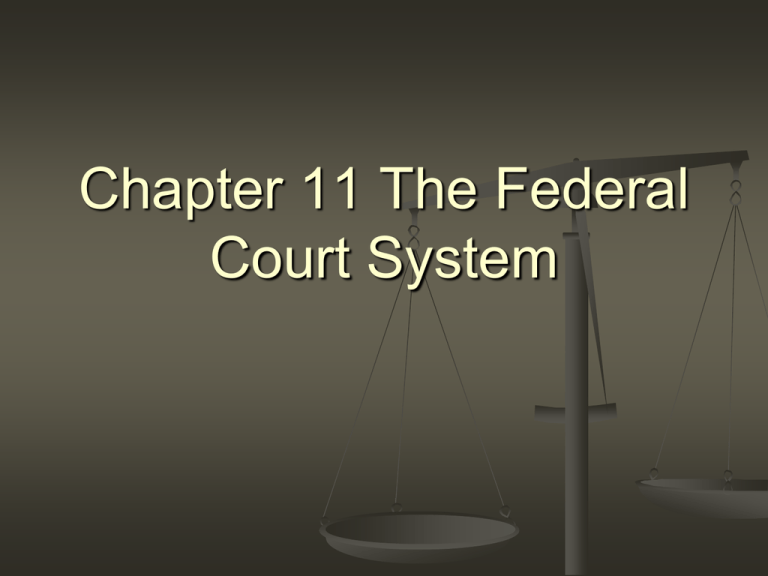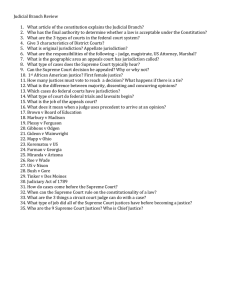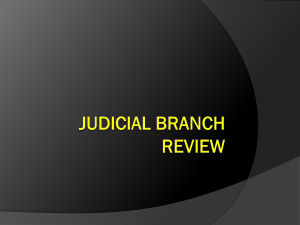Chapter 11 The Federal Court System
advertisement

Chapter 11 The Federal Court System I. Powers of the Federal Courts Supposed to balance the other two branches Really had no power until Chief Justice John Marshall was appointed chief justice in 1801 A. Jurisdiction of the Courts Each state has its own courts system 1. Federal Court Jurisdiction Jurisdiction: authority to hear certain cases Some overlap from state courts They hear cases on U.S. laws, treaties, or interpretations of the Constitution There are also special situations they hear cases on A. Jurisdiction of the Courts cont. 2. Concurrent Jurisdiction Both federal and state courts have jurisdiction 3. Original and Appellate Jurisdiction Trial court where the case is originally heard is the original jurisdiction Appellate jurisdiction: appeals for previously heard cases B. Developing Supreme Court Power The court has developed from custom, usage, and history 1. Early Precedents Justice may not seek out cases 2. Marbury v. Madison 1801, Adams’ midnight judges appointments were challenged Established judicial review Power to review acts of Congress 3. John Marshall’s Influence Litigants have to bring them a case The court established its power under his guidance Gained power over state laws, contracts, interstate commerce, and tax laws Federal govt. grew more powerful 4. States’ Rights Era and the Scott Case Marshall died 1835, replaced by Roger Taney Jackson appointed seven justices who supported states’ rights Dred Scott case 1857 C. Due Process 14th Amendment guaranteed citizenship to all Due process clause of it was routinely challenged 1. Slaughterhouse Cases 1898, upheld segregation 3. The Court and Business 1873, courts ruled the rights did not extend protection, simply protected them 2. Plessy v. Ferguson State may not deprive any person of life, liberty, or property w/o due process of law Upheld several monopolies in the late 19th century Changed during the progressive era 4. Protecting Civil Liberties Modern court has protected individuals 1954, Brown v. Board of Education II. Lower Federal Courts Judiciary Act of 1789 est. many of the lower courts A. Constitutional Courts Est. in Article III Federal district courts, federal court of appeals, and U.S. court of international trade 1. Federal District Courts Trial courts 94 districts today 550 judges For criminal and civil federal cases Grand juries may issue indictments for this 16 to 23 people Petit juries hear the actual trial 6 to 12 people A. Constitutional Courts cont. 2. Officers of the Court Each has prosecutors, magistrates, judges, and U.S. marshals 3. Federal Court of Appeals Created in 1891 to lighten the case load of the Supreme Court 13 U.S. courts of appeals Divided into 12 judicial circuits 1 appellate court in each region 13th is a special national court Usually a panel of three judges hears cases Can uphold a case, reverse it, or send it back to lower courts 4. Court of International Trade Customs Court Deals with tariffs Based in NYC B. Legislative Courts Help Congress exercise its power 1. U.S. Court of Federal Claims 2. U.S. Tax Court Military’s highest appeals court 4. Territorial Courts Dispute the IRS or Treasury Dept. 3. U.S. Court of Appeals for the Armed Forces Claims against the govt. Virgin Islands, Guam, Puerto Rico, etc. 5. Courts of the District of Columbia 6. The Court of Veteran Appeals 7. Foreign Intelligence Surveillance Court For wiretaps and other spy related cases C. Selection of Federal Judged Presidential appointment and Senate approval 1. Party Affiliation Presidents favor their own party, usually 2. Judicial Philosophy Serve for life A means to perpetuate the President’s political views 3. Senatorial Courtesy Pres. Submits nominees to the Senators from that state If one disapproves, the nomination is withdrawn 4. Background of Federal Judges Almost all of them have legal training from top schools Recently, more women and minorities are gaining seats III. The Supreme Court The court of last resort in all federal law 9 justices serve for life Decisions are binding to lower courts Until 1891, justices still had to ride the circuit Hears mainly appeals from lower courts Traveling to hold court in regions All cases are heard in Washington today A. Supreme Court Jurisdiction Has both original and appellate jurisdiction Hears original cases involving: Representatives of foreign govts. Cases where a state is a party Small case load Appellate cases fill the docket Hears cases that involve the Constitution Also oversees acts of Congress and treaties B. Supreme Court Justices Nine justices Paid $208,000 per year One chief justice and eight associate justices Congress has the power to change the number FDR tried to “pack” the court during the New Deal Congress sets their wages and cannot reduce them Congress may impeach justices and remove them Justice Samuel Chase was impeached in 1804 and acquitted B. Supreme Court Justices cont. 1. Duties of the Justices Not described in the Constitution Developed from laws, tradition, and specific needs Main duty: hear and rule on cases Deciding which cases to hear Deciding the cases Expressing their explanation in the Court’s opinion Each justice oversee a federal district Special situations Justice Robert Jackson presided over the Nuremburg Trials Justice Earl Warren investigated the Kennedy assassination B. Supreme Court Justices cont. 2. Law Clerks Assist the justices with their tasks 3. Background of the Justices No Constitutional requirements 6 were born outside the U.S. There have been 104 justices 102 men, 2 women Most were judges before William Howard Taft served after his presidency Does not represent the general population demographics Ex. Two African Americans C. Appointing Justices Appointed by the President and approved by the Senate One of Washington’s choices was rejected 25% of nominees were rejected in the 19th century More supportive now Some justices had different political ideas than the president thought Rejected two of Nixon’s and one of Reagan’s Clarence Thomas faced great scrutiny Ike and Earl Warren Attorney General and the Justice Dept. help the Pres. C. Appointing Justices cont. 1. The Role of the American Bar Assoc. (ABA) Largest national organization of attorneys Consult with the president for nominations 2. The Role of Other Interest Groups Rate nominees’ qualifications Labor Unions, Natl. Org. for Women, or other groups can oppose candidates Roe v. Wade has big influence 3. The Role of the Justices Chief justices are often active in the selection process Write letters of recommendation







